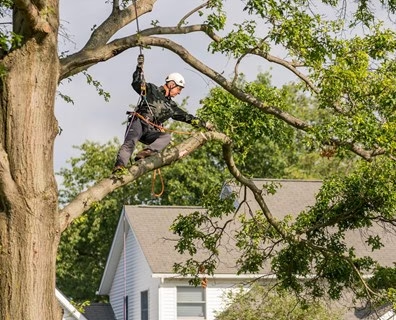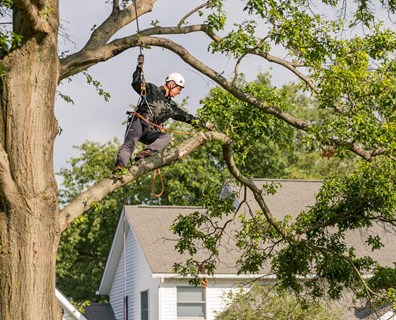Winter Tree Trimming Tips. What most people do not realize is that winter is the absolute best time to prune deciduous shrubs and trees.
Winter Tree Trimming Tips.
This is because the shrubs and trees are “asleep” or “dormant” during this time.
You can prune as soon as they go to “sleep”.
While the tree is dormant, it won’t bleed sap.
Insects seek out sap and will eat on the tree if it’s leaking sap.
Winter pruning promotes growth of buds in the spring so you will have flowers later.
Winter Tree Trimming will help your tree to withstand the effects of wind.
Also, snow, and ice and can keep the ice from breaking the branches.
Pruning during the winter is needed.
Because during this time there is less chance of transmitting a tree disease.
Insects aren’t around to eat at the wounds that pruning makes.
Since there are no leaves on the trees, it makes it so much easier to see dead branches.
Also, diseased branches or anything else that needs to be pruned.
During the wintertime, trimming is great for the dormant trees.
But is absolutely necessary for any oak that needs to be pruned.
The reason is that 0ak, when cut, gives off a certain smell that insects, especially beetles, love.
Beetles can carry diseases from one tree to another.
Oak wilt, a very deadly disease, is carried by beetles and would most likely kill your oak.
During the winter, beetles hide, which is why wintertime is the only time to prune oak.
Some trees are not as likely to get diseases, so for example.
You should prune crabapple, hawthorn, mountain ash, and apple trees to prevent fire blight.
You should prune locust to avoid stem canker.
Now here are five winter tree pruning tips that will help you do the job right.
Tip one: Planning.
You need to decide ahead of time exactly what it is you want to do to the tree/shrub.
There are many different styles of pruning but for dormant trees/shrubs the “natural style” is the way to go.
By “natural style” I mean that you should keep the natural shape and outline of the plant.
Tip two: Remove Branches That Won’t Survive.
Prune any dead branches, any branches or other parts that are diseased.
Also remove the suckers and water sprouts near the trunk of the tree.
Remove any branches that may be rubbing against each other.
Also thin out the canopy.
So that air and sunlight can get through but try to remove only about one quarter of the canopy.
Tip three: Absolutely no stubs!
Make sure that there are no stubs left behind.
Because it encourages sucker growth and will eventually destroy the natural shape.
And outline of your tree making it vulnerable to many diseases.
Tip four: Inspect For Insects
Before pruning you will need to check for any insect infestations.
Caterpillars and tussock are usually a problem and can be seen on the branches.
Also check for open cuts or lumps that can be a sign of disease.
Tip five: Safety Gear.
Along with taking precautions for your trees and your shrubs.
you need to remember to take precautions for yourself as well.
You need to make sure that you have the right tools.
And that you are familiar with those tools before ever trying to use them.
Make sure that you always wear eye protection, the reason why should be obvious.
Always make sure that you wear gloves when pruning.
If you have a huge tree that needs to be pruned then you might want to hire a professional arborist.
To do the job just to be on the safe side.
Below are some more tips to help you make sure that you are doing the job right.
And just a few “dos” and “do nots” to guide you along the way.
DO cut the larger branches into small cuts.
Cut one third of it to lessen the weight.
Then undercut the stub that is left.
You undercut it so that the bark will not rip off when the stub falls.
Last, you cut the final time at the top by the “branch collar”.
Winter Tree Trimming Tips.
Make sure to cut at an angle, mirroring the collar of the branch (where the trunk and branch meet).
If your tree is healthy, no diseases, it will seal around the cut and heal fine.
Do not top your tree.
Flat top trees are plain ugly, not to mention that it will weaken the tree.
Leave any stubs behind at all!
Make sure that you make smooth, clean cuts to promote healing.
I’ve included a list of tools you will need to get you started on your pruning journey.
Before anything, check your tools.
Make sure the blades are sharp and all tools are in good working order.
This will help to prevent harming your trees and shrubs.
A pruning saw called a lopper.
Would be a better choice to use for thicker branches that are two-to-three inches thick.
A pruning saw has widespread teeth and can actually handle a branch up to eight inches thick.
Hand pruners.
These are used to remove smaller branches around a half inch-to-an inch thick.
IMPORTANT:
Make sure to clean all of your tools when you are finished pruning.
This will extend the life of your tools.
My advice would be to rinse them in a bleach solution of one-part bleach and ten parts water.
This will help to prevent the spread of any disease that any of your branches may have had.
Once this is done, dry your tools completely to prevent them from rusting.
As with anything in life there are exceptions.
There are some trees, that due to sap bleeding extensively, it would be best to prune in mid-summer.
Or after the last blooms are gone.
Dormant magnolias and flowering cherries.
Are just two of those that need to be pruned as soon as the blooms fade.
Following these tips and rules. Dos and do nots, should leave you with beautiful trees and shrubs.
Gardening should be a relaxing and enjoying experience.
So make sure to keep your trees and shrubs healthy so you can enjoy them.
No one wants to see their beautiful plants die. Pruning at the right time is the answer!

